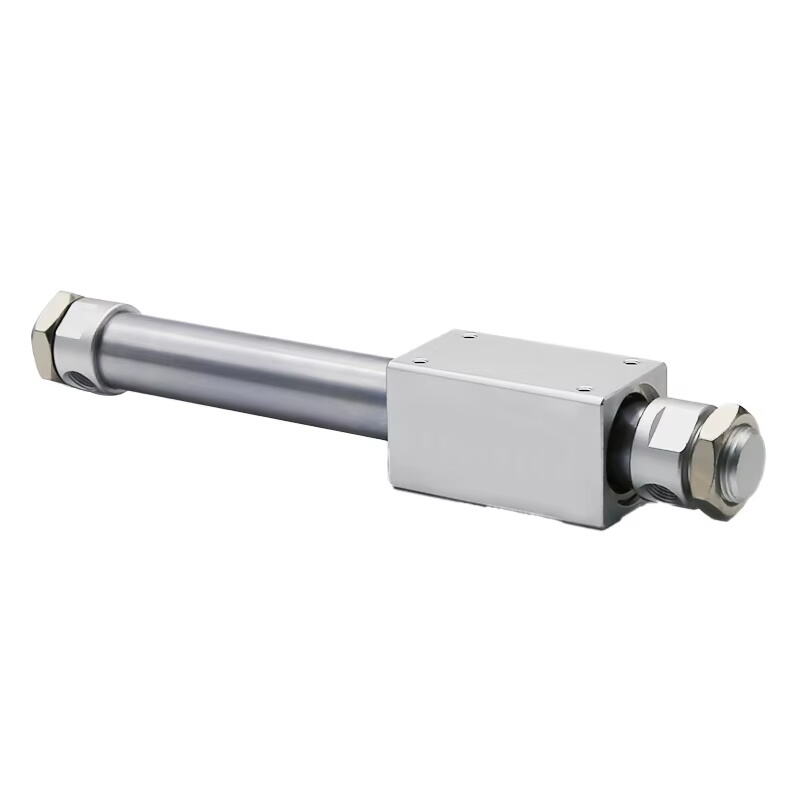Introduction
What does a massive industrial press, a delicate packaging machine, and an automated car wash all have in common? They all rely on the controlled, powerful, and reliable motion provided by a single core component: the pneumatic cylinder. Often called the "muscles" of automation, cylinders are the workhorses that convert compressed air energy into linear mechanical force. But not all cylinders are created equal. Choosing the wrong type can lead to inefficiency, premature failure, and costly downtime. This comprehensive guide will demystify the three primary types of pneumatic cylinders, empowering you with the knowledge to select the perfect one for your application, optimize your system's performance, and ensure long-lasting reliability.
Why Understanding Cylinder Types is Crucial for Your System
Selecting the appropriate cylinder is a fundamental engineering decision that impacts nearly every aspect of your operation:
Performance and Efficiency: The right cylinder ensures you get the precise force, speed, and stroke length required for the task. A mismatched cylinder can lead to sluggish operation, insufficient clamping force, or wasted energy.
Cost of Ownership: An over-specified cylinder wastes upfront capital, while an under-specified one will fail prematurely, increasing maintenance and replacement costs. The correct choice balances performance with budget.
Space Optimization and Design: Different cylinder types have vastly different footprints. Understanding these differences allows engineers to design more compact and efficient machinery.
Reliability and Uptime: Selecting a cylinder built for its specific duty cycle and environment (e.g., clean, dirty, washdown) is key to maximizing its service life and minimizing unplanned production stops.
What is a Pneumatic Cylinder? The Core Concept
A pneumatic cylinder is a mechanical device that uses compressed air to produce force in a linear, back-and-forth motion. This force is generated by compressed air acting upon a piston inside a cylindrical barrel. The piston is connected to a rod that extends and retracts, providing the push or pull to move a load.
Key components include:
Barrel: The tube that contains the pressure.
Piston: The component that moves inside the barrel, separating the two pressure zones.
Rod: The hardened, precision-ground shaft that transmits the force to the machine.
End Caps: Seal the ends of the barrel.
Seals: Critical for preventing air leakage and ensuring efficient operation.
The Three Primary Types of Pneumatic Cylinders
While there are many specialized designs, most pneumatic cylinders fall into one of three fundamental categories.
1. Single-Acting Cylinders
What Are They?
A single-acting cylinder (SAC) uses compressed air to generate force in only one direction—typically to extend the piston rod. The return stroke (retraction) is accomplished by an internal spring mechanism. This means they have only one air port.
How Do They Work?
Extension: Compressed air is supplied to the single air port, pushing the piston against the spring and extending the rod.
Retraction: When the air supply is exhausted, the stored energy in the spring forces the piston back, retracting the rod and pushing the air out of the port.
Advantages and Disadvantages
-
Advantages:
Simpler Design & Lower Cost: Fewer parts and a single air connection make them more economical to purchase and install.
Fail-Safe Retraction: In the event of a power or air failure, the spring automatically retracts the rod. This is critical for safety in applications like clamping (e.g., if power is lost, the clamp releases).
Compact: Often more compact than a comparable double-acting cylinder because the spring is housed within.
-
Disadvantages:
Limited Force and Stroke: The spring takes up space and provides the return force, which limits the available stroke length. The force is also not constant on the out-stroke—it diminishes as the spring compresses.
Spring Wear: The spring is a mechanical component that can fatigue over time, especially with high cycle rates, leading to a failure to fully retract.
Energy Inefficiency: Energy is consumed to compress the spring on the out-stroke, which is wasted as heat on the return stroke.
2. Double-Acting Cylinders
What Are They?
A double-acting cylinder (DAC) uses compressed air to generate force in both directions, both to extend and to retract the piston rod. They have two air ports—one for extension and one for retraction. This is the most common and versatile type of cylinder found in industrial applications.
How Do They Work?
Extension: Compressed air is supplied to port "A" while port "B" is exhausted. This pressure difference pushes the piston, extending the rod.
Retraction: Compressed air is supplied to port "B" while port "A" is exhausted. This pushes the piston in the opposite direction, retracting the rod.
Advantages and Disadvantages
-
Advantages:
Full Control: Precise control over the motion in both directions is possible through valves and flow controls.
Constant Force: The force output is theoretically identical in both directions (minus the small area difference due to the rod on the retract side). Force is determined by air pressure and piston area, not a spring.
Longer Strokes & More Sizes: No internal spring allows for a much wider range of bore sizes and stroke lengths.
More Efficient: No energy is wasted compressing a spring.
-
Disadvantages:
Higher Cost: More complex with two ports, making them slightly more expensive.
No Default Fail-Safe: In a power loss, the cylinder will remain in its last position unless a specific control system (like a pilot-operated valve) is used to create a fail-safe condition.
Slightly Larger: For a given bore and stroke, they can be longer than single-acting cylinders.
3. Rodless Cylinders
What Are They?
Rodless cylinders are a space-saving alternative. They produce linear motion from a piston that moves within a barrel, but unlike traditional cylinders, the piston is connected to an external carriage without a protruding rod. The load is mounted directly to this carriage.
How Do They Work? There are three main internal mechanisms:
Magnetic Coupling: The piston has a strong magnet. The external carriage has another set of magnets, creating a non-contact force transfer through the cylinder wall. Leak-free but limited force.
Mechanical Coupling (Slot Seal): A slot runs the length of the barrel. A piston-driven mechanism protrudes through this slot and is connected to the carriage. A flexible stainless steel band seals the slot as the carriage moves.
Cable or Belt: The piston is attached to a cable or belt that runs over pulleys at each end, connected to the external carriage.
Advantages and Disadvantages
-
Advantages:
Massive Space Savings: The overall length is roughly equal to the stroke length, unlike rod-type cylinders which can be twice their stroke length when retracted. This allows for incredibly long strokes in compact spaces.
Resists Bending & Buckling: With no rod to buckle, they can handle higher moment loads and are ideal for applications with side loads.
Uniform Force & Speed: Force and speed are consistent across the entire stroke because there is no rod volume to fill on one side.
-
Disadvantages:
Higher Cost: More complex manufacturing leads to a higher initial cost.
Potential for Leakage: Mechanically coupled models have a small potential for leakage across the slot seal.
Limited Load Capacity (Magnetic): Magnetically coupled models have a lower maximum force capacity.
How to Choose: A Step-by-Step Selection Guide
Use this checklist to navigate the selection process:
-
Define the Motion Requirement:
Does the load need to be moved in one direction only, with automatic return? - Single-Acting
Does the load need powered motion in both directions? - Double-Acting
Is space extremely limited, especially along the axis of motion? - Rodless
Calculate the Force Needed: Use the formula: Force (lbs) = Pressure (PSI) x Piston Area (in²). Remember to calculate for both extend and retract (for DACs). Always apply a safety factor (e.g., 1.5-2x).
Determine the Stroke Length: How far must the load move? This will immediately rule out SACs for longer strokes and make rodless cylinders attractive.
Consider the Operating Environment: Is it clean, dirty, corrosive, or a washdown area? This will dictate required materials (e.g., stainless steel body & rod) and rod seal types.
Analyze the Mounting: How will the cylinder be attached to the machine? Common mounts include foot, flange, trunnion, and clevis. The mounting style significantly affects how the cylinder absorbs load forces and must be chosen to minimize stress.
Select the Bore Size: Based on your force calculation and available air pressure, select a standard bore size .
Conclusion: Powering the Right Motion
Understanding the distinct roles of single-acting, double-acting, and rodless cylinders is the first step toward designing efficient, reliable, and cost-effective pneumatic systems. There is no single "best" type—only the best type for your specific application. By carefully evaluating your requirements for force, motion, space, and safety, you can confidently select the cylinder that will serve as the perfect muscle for your automation needs.

